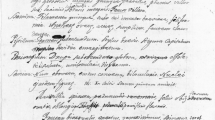Summary
The typification of the Linnaean name Rhinanthus indicus (= Centranthera indica) is discussed. The designation of the nomenclatural type is based on an assessment of Linnaeus’ original materials and the literature cited in the protologue. The name is lectotypified using a specimen from the Paul Hermann Herbarium at BM. In addition, two other names, Centranthera hispida and Digitalis stricta (both synonyms of Centranthera indica), are also lectotypified.




Similar content being viewed by others
References
Brown, R. (1810). Prodromus Florae Novae Hollandiae et Insulae van-Diemen. J. Johnson & Co., London.
Burman, J. (1737). Thesaurus Zeylanicus. Apud Janssonio-Waesbergios & Salomonem Schouten, Amsterdam.
Cramer, L. H. (1981). Scrophulariaceae. In: M. D. Dassanayake & F. R. Fosberg (eds), A Revised Handbook to the Flora of Ceylon, Vol. 3: 386 – 438. Amerind Publishing Co., New Delhi.
Gamble, J. S. (1924). Flora of the Presidency of Madras, Part 6 (Scrophulariaceae to Plantaginaceae). Adlard & Son Ltd., London.
Jarvis, C. (2007). Order out of Chaos: Linnaean Plant Names and their Types. Linnean Society of London and Natural History Museum, London.
Linnaeus, C. (1747). Flora Zeylanica. Laurentius Salvius, Stockholm.
Linnaeus, C. (1753). Species Plantarum. Laurentius Salvius, Stockholm.
Mabberley, D. J. (2008). Mabberley’s Plant Book, A Portable Dictionary of Plants, their Classification and Uses, 3rd ed. Cambridge University Press, Cambridge.
McNeill, J., Barrie, F. R., Buck, W. R., Demoulin, V., Greuter, W., Hawksworth, D. L., Herendeen, P. S., Knapp, S., Marhold, K., Prado, J., Prud’homme van Reine, W. F., Smith, G. F., Wiersema, J. H. & Turland, N. J. (2012). International Code of Nomenclature for Algae, Fungi, and Plants (Melbourne Code), Adopted by the Eighteenth International Botanical Congress Melbourne, Australia, July 2011. Regnum Veg. 154. Koeltz Scientific Books, Königstein. http://www.iapt-taxon.org/nomen/main.php
Roxburgh, W. (1832). Flora Indica, Vol. 3. W. Thacker & Co., Calcutta.
Stearn, W. T. (1957). An introduction to the Species Plantarum and cognate botanical works of Carl Linnaeus. In: C. Linnaeus (ed.), Species Plantarum, Facsimile, Vol. 1: 1 – 157. Ray Society, London.
Trimen, H. (1887). Hermann’s Ceylon herbarium and Linnaeus’s ‘Flora Zeylanica’. J. Linn. Soc., Bot. 24: 129 – 155.
Acknowledgements
I thank Dr P. Singh, Director, Botanical Survey of India, Kolkata and the Head of Office, Botanical Survey of India, Southern Regional Centre, Coimbatore for facilities. I am also grateful to the Curators of BM and K for information and images of type specimens.
Author information
Authors and Affiliations
Corresponding author
Rights and permissions
About this article
Cite this article
Singh, R.K. Lectotypification of the Linnaean name Rhinanthus indicus (Orobanchaceae). Kew Bull 73, 49 (2018). https://doi.org/10.1007/s12225-018-9774-1
Accepted:
Published:
DOI: https://doi.org/10.1007/s12225-018-9774-1




